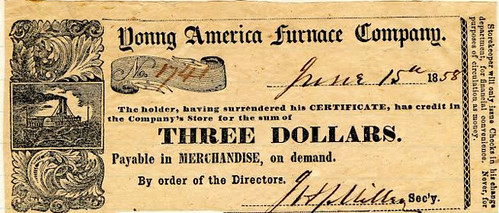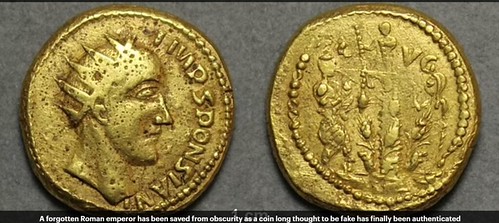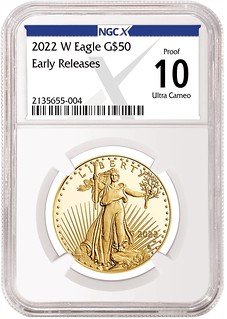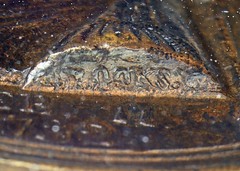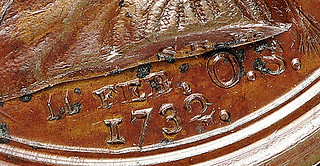
PREV ARTICLE
NEXT ARTICLE
FULL ISSUE
PREV FULL ISSUE
V25 2022 INDEX E-SYLUM ARCHIVE NOTES FROM E-SYLUM READERS: DECEMBER 4, 2022
Young America Furnace Company Note Misspelling Last week I asked, "what word on the note is misspelled? " -Editor "I make occasional mistakes, but I spell it as young." Correct. On some of the notes the word "Young" is spelled "Yonng". I attribute this to an error in typesetting, made more likely because the letters "u" and "n" are identical upside-down. -Editor
To read the earlier E-Sylum article, see:
More on the Sponsian Coin "I found the discussion about the mystery Sponsian coin interesting. I was surprised that other numismatists were not mentioned in the news items, although the Hunterian is highly regarded. The reverse looks very odd and seems to be overstruck or badly cut.
Quite true.
That article really went viral, travelling everywhere before other numismatists had much chance to chime in. Thanks to our readers who expressed their opinions and doubts. -Editor
To read the earlier E-Sylum article, see:
Economist Article on the Sponsian Coin The Economist has a long article on the analysis of a hoard found in 1713 in Romania. Thanks - this is the same topic - the coins of Sponsian. -Editor
To read the complete article (subscription required), see:
On the NGCx 10 Point Grading Scale
"I have been hearing for many years about changing the grading scale to 100 points, so numismatics matches other collectibles like sports cards. "As a collector, It really doesn't really matter to me which scale is used, but I can already see this as a heyday for dealers and grading companies hyping the new scale, collectors changing holders to the new scale and so on.
"I can imagine someday that the old (current) holders will be desired by the crack out artists. Buy at "It might bring in some new collectors since it is a more understandable scale for newbies. "I think it was very smart for NGC to launch the new grading scale the way that they have. Will this be like the Regency PCGS holders? Time will tell." Tom Bridgeman writes: "In regards to NGC going to a 10 point grading scale.....just another scam they are trying to push for profit. The grading business as it stands is quite questionable and full of misattributed and miss-graded coins...now they want to stir things up and "potentially" hope everyone goes back to having graded coins Re-Graded, at a fee of course! As you may have noticed, but I have a very biased opinion of the 'Slabbing" system, but it is an honest and fair opinion of a new money grab idea."
To read the earlier E-Sylum article, see:
Samuel Brooks and the Manly Medal "I read with interest the article on medal collecting and heartily endorse what it says! "There is more real estate on medals, they are often more artistic, more historic, often in better condition, more diverse, and more rare. "The paragraph that starts Medal Collecting in America however, may be incorrect. "The description of the Manly medal as engraved by Joseph Wright prompts me to show these photos of the truncation of the original and second obverse truncations of Washington's shoulder. "The first obverse medal (Musante GW-10) was engraved with S BROOKS F on the truncation (i.e., Samuel Brooks fecit). The second obverse medal (Musante GW-11) was engraved with SBF on the truncation. "According to Musante's Medallic Washington, Baker's Medallic Portraits of Washington, and the Forrer Biographical Dictionary of Medallists, the engraver was Samuel F. Brooks, who Manly employed to engrave the dies. Brooks was a goldsmith and seal-engraver in Philadelphia around 1793 and engraved the Manly medal in 1790. He relocated to Norfolk, Virginia in 1795 as a successful silversmith and engraver. "Joseph Wright did not engrave the medal. The medal was not taken from a Washington portrait in 1784. James Manly, an English artist entrepreneur, traveled to Boston to make an engraved copy of the Christian Gullager oil portrait of Washington (circa 1789) hanging there. Brooks used this as a base for his die engraving of Washington." Thank you for setting the record straight. -Editor
To read the earlier E-Sylum article, see:
Wayne Homren, Editor The Numismatic Bibliomania Society is a non-profit organization promoting numismatic literature. See our web site at coinbooks.org. To submit items for publication in The E-Sylum, write to the Editor at this address: whomren@gmail.com To subscribe go to: https://my.binhost.com/lists/listinfo/esylum All Rights Reserved. NBS Home Page Contact the NBS webmaster 
|
